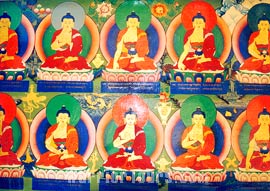Buddhism in China

In the Han Dynasty (206 BC --- 220 AD), Buddhism spread into China and soon prospered. Buddhism played an important role in Chinese culture and history.
Generally, Buddhism in China can be categorized into Han Buddhism, Tibetan Buddhism and Southern Buddhism. Han Buddhism and Tibetan Buddhism are important divisions of the religion, since they keep many important Buddhist scriptures translated from the Sanskrit editions, which are extinct in India due to demolition happened there many years ago. Namas Amitabha!
![]() Han Buddhism
Han Buddhism
Han Buddhism refers to the Buddha's religion spreading in Han area and mingling with Han culture. Buddhism formally spread into China, mainly Han area during the Han Dynasty (206 BC --- 220 AD), although there are historical records indicating Buddhist missionaries came China during the Qin Dynasty (221 --- 206 BC).

In the Three Kingdoms Period (220-265), outstanding monks and Buddhist scholars launched large-scale project of sutra translation. During the Northern and Southern Dynasties (386 --- 589), since most emperors believed in it, Buddhism grew rapidly despite the demolition incidents. In the Northern Wei Dynasty (386-534), the famous Yungang Caves and Longmen Caves were hewn, and Buddhist population amounted up to 2 million.
Until the Northern Qi Dynasty (550-557), official Buddhist registration was more than 4 million. Many famous foreign monks came China to promote and Chinese monks trekked to India to study Buddhism and bring back with them many sutras.
After the Sui Dynasty (581 --- 618) was established, Buddhism restored its flourish under the imperial protection and promotion. Sutra translation continued to boom. Buddhism met its golden time in the Tang Dynasty (618 --- 907). Many temples were set up and famous monks home and abroad were invited to translate sutras. The outstanding Tang monks made unprecedented achievement in Buddhism study and research. Then Buddhism began to split into different sects, some of which later spread into Japan, Korea, Vietnam and Indonesia. It was also the Tang Dynasty when Buddhism was introduced into Tibet with imperial marriage. By the Song dynasty, Han Buddhism slowed its pace due to lost of imperial support. In the Yuan Dynasty (1271 --- 1368) and the Qing Dynasty (1644 --- 1911), Tibetan Buddhism won imperial favor, while Han Buddhism made a comeback in Ming Dynasty (1368 --- 1644) and revived after the reign of Emperor Kangxi.

It belongs to the Mahayana school which, also named Big Vehicle, believes that the Buddha did not just point the way and float off into his own nirvana, but continues to offer spiritual help to others seeking nirvana and Buddhist individuals should bear altruism. The division has mainly 8 sects: Zen Sect, Tantra Sect, Pureland Sect, Tiantai Sect, Sanlun Sect, Faxiang Sect, Lu Sect and Huayan Sect, of which Zen and Pureland are the most famous.
Zen, Chan in Chinese and Dhyana in Sanskrit, is the most important and influential sect of the Han Buddhism. It means meditation. This sect of Mahayana Buddhism aims to transmit the essence of Buddhism. Zen advocates the ability to achieve enlightenment is inherent within everyone but lies dormant because of ignorance. It holds that a sudden breaking through of the boundaries of common, everyday, logical thought is the right way. Although Bodhidharma was respected as the founder of Zen Buddhism, it was actually established by Huineng, successor of Bodhidharma' lineage. Later, it split into 2 sects and 7 subsects, some of which soon were introduced to Japan and Korea. Now, Zen is still very popular among Buddhism followers.
Famous Buddhist Holy Mountains:Mt. Jiuhua; Mt. Emei; Mt. Putuo; Mt. Wutai.
There are so many famous Buddhism temples in China that it is difficult to list hundreds of temples here. Interested viewer can find those temples in the cities where they are located.
![]() Southern Buddhism
Southern Buddhism
Southern Buddhism refers to Pali Buddhism introduced into Yunnan province from Myanmar in the 7th century. At the beginning, there was no Buddhist temple and its scriptures were spread orally. In the 11th century, Buddhism faded due to warfare. After wars ceased, Buddhism was reintroduced into Dai majority tribes from Thailand and Myanmar. Pattra sutra written in Dai language started to appear after the language was invented in 1277. When a Myanmar princess was married to the 19th Yunnan magistrate in 1569, the King of Myanmar sent a Buddhist mission to Yunnan, bringing with them Buddhist scriptures and statues. Soon, temples were built up and Dai people and a few other minorities converted to the Pali Buddhism.
Now Southern Buddhism can be divided into four sects. Dai boys must spend a monastery life when they reach school age. They will be taught in monasteries and may drop out when they reach their adulthood. The outstanding ones may stay for further studying and become formal monks. The Southern Buddhists can be gradually ranked and the one sits on the top of the pyramid is the religious leader.

